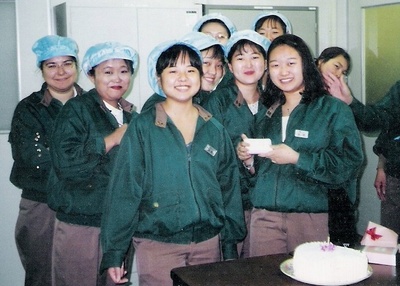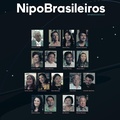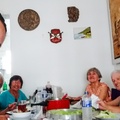Acabei relembrando os tempos como dekassegui, ao visitar uma cidade na qual ainda residem muitos deles, apesar da crise que também afetou este país. Foram apenas dois dias, mas que trouxeram lembranças de um período inteiro.
O dia começava bem cedo. Começava mais cedo ainda para minha querida mãe, que preparava com carinho nosso obentô.1 Que saudades de sua comida! Acordávamos cedo para esperar o ônibus da empreiteira. Levava cerca de quarenta minutos para chegar à fábrica e nesse percurso, o motorista passava pontualmente em vários pontos para buscar outros dekasseguis também. No caminho, geralmente íamos ouvindo música ou dormindo.
Ao chegar na fábrica, batíamos o cartão de ponto, guardávamos nossos pertences e fazíamos taisô, no pátio externo. O taisô, a ginástica laboral, era odiado por alguns principalmente no inverno. Era feito três vezes ao dia: antes do início do trabalho, no meio da manhã e no meio da tarde. Até que ajudava a espantar o sono e relaxar um pouco.
Depois de entrar na fábrica e colocar o jaleco, passávamos nossas horas colando peças de aparelhos eletrônicos – celulares, notebooks, televisores e impressoras. Trabalhávamos sentadas e por isso era considerado um trabalho bem leve. As vagas nesta fábrica eram famosas e procuradas. Geralmente, o expediente ia até o fim da tarde, mas cheguei a ficar até 10h da noite e tivemos muitos finais de semana de trabalho. Eu preferia trabalhar o quanto pudesse, não me importava em trabalhar nos finais de semana porque isso fazia com que me sentisse bem, já que estava ali a trabalho e, é claro, receberia mais no final do mês.
Durante o expediente, não tinha muito no que se pensar, a não ser no futuro, no Brasil e em sonhos. Era um trabalho muito repetitivo e eu sentia como se minhas capacidades estivessem atrofiando. Não era permitido conversar, mas se fosse baixinho, ninguém vinha reclamar. Então, sempre quando possível, conversávamos sobre como era nossa vida no Brasil, sobre nossos sonhos e planos. Nos primeiros dias, senti muitas dores nos ombros e nas mãos, mas depois de 1 mês, acostumei e já não as senti mais. Uma das recompensas que eu me dava era comprar suco na maquininha ou ir comer em restaurante. Então, foi passando os dias assim, que alimentei minha vontade em voltar para meu país e realizar o que havia interrompido.
Havia também o turno noturno. Alguns funcionários trocavam o dia pela noite, entrando na fábrica às 8 horas da noite e saindo às 7 horas da manhã, quando a outra turma de funcionários chegava. Para mim, aquilo seria uma rotina muito mais desgastante, mas havia pessoas que preferiam o trabalho noturno.
Eu era a funcionária mais nova da fábrica, cheguei com 17 anos. Permitiram que eu fizesse horas extras quando completei 17 anos e meio. Conversando com as outras moças, sentia que era necessário ter forças, não queria deixar acontecer comigo o que aconteceu com algumas: perder a previsão de retorno ao Brasil, ou engravidar, gastar as economias e precisar ficar mais tempo. Mas não era necessário muito esforço, pois a única coisa que eu desejava era voltar a estudar. Só pensava nisso. Cheguei a conhecer 2 garotos, mas como eles não tinham ambições na vida e planos, senti que não valia a pena ter algum relacionamento sério.
Era tudo bastante acessível no dia-a-dia e mesmo não sabendo muito a língua japonesa, isso acabava fazendo falta só em alguns momentos. Nosso líder de seção também era brasileiro, o que facilitava a comunicação no ambiente. Já havia estudado um pouco de japonês no Brasil, mas apliquei e aperfeiçoei pouquíssimo. Precisei usar a língua japonesa em poucas oportunidades, por exemplo, em lojas e restaurantes. Cidades com alta concentração de dekasseguis, tem lojas de produtos brasileiros com açougue, padaria, revistaria e lanchonete, obviamente com atendimento em português. Há revistas direcionadas para dekasseguis, com muitos anúncios de serviços referentes às suas necessidades e também tudo em português: venda de celulares e outros aparelhos eletrônicos, transportadoras de mudanças para o Brasil, roupas e perfumes brasileiros. Também existia uma espécie de locadora ambulante, de filmes legendados e novelas brasileiras em fitas de vídeo. Era um caminhãozinho que passava de porta em porta para oferecer o aluguel das fitas. A realidade é que voltei para o Brasil com um conhecimento muito básico sobre o Japão em todos os aspectos. De lugares famosos, conheci o Monte Fuji, Tokyo Disneyland, Suzuka Circuit e a Universal Studios. De culinária, apreciei o básico - sushi, sashimi, udon.
Filhos de dekasseguis tem a opção de frequentar escolas brasileiras no Japão. Minha irmã estudou em uma delas, pois achávamos que 2 anos era pouco tempo para se adaptar em uma escola japonesa e seria sacrificante demais para uma garota de 13 anos. No caso dela, os 2 anos transformaram-se em 4 e quando ela ingressou no colegial, meu medo era de que ela se perdesse e não tivesse mais sonhos, que se contentasse com a vida que estava tendo e que tivesse como sonho o trabalho em fábricas. Isso é realmente muito comum. Há pais que acham conveniente que os filhos trabalhem como eles, para não terem gastos com as mensalidades da escola. Já, os filhos, convivendo com dekasseguis, deixam de ter pessoas para se espelhar, para imaginar um futuro diferente e acabam também achando fácil obter dinheiro para o que quiserem comprar, ainda mais no mundo dos eletrônicos. Felizmente, com a devida orientação de minha mãe e sua própria força de vontade, isso não aconteceu em nossa família e minha irmã retornou ao Brasil para cursar o 3º ano do Ensino Médio.
Com uma imensa vontade de voltar a estudar o quanto antes, não agüentei a meta de ficar 2 anos. Fui embora em 1 ano e meio. Felizmente, as coisas seguiram conforme eu imaginei. O cursinho pré-vestibular durou 5 meses e eu estudava o dia todo, só parando para as refeições. Sentia-me impotente às vezes, por ver alguns estudantes freqüentando o cursinho há anos ou meses a mais que eu, e pensava: “Fiquei 1 ano e meio praticamente sem estudar, como é que irei disputar uma vaga na universidade, sendo que tantos deles estudam há mais tempo que eu?”. Mesmo assim, procurei não desanimar. Pensava que mesmo não sendo aprovada, quanto mais estudasse, mais estaria adiantando para o ano seguinte de estudos. Com muito alívio e alegria, consegui estudar em universidade pública.
Sei que existem opiniões e histórias diferentes. Tudo depende da visão que temos das coisas e das situações pelas quais já passamos. Porém, como bolsista, passamos por oportunidades e experiências totalmente diferentes da época que tive como dekassegui e a intenção deste artigo é compartilhar minha história, seja para incentivar a reflexão ou para mostrar um pouco do mundo dos dekasseguis. É claro que cada um pode escolher como ser feliz e é importante não desistir disso.
Notes:
1. Obentô é o nome dado à marmita japonesa, porém é uma palavra usada comumente entre os nikkeis também, para se referir a qualquer marmita.
© 2010 Silvia Lumy Akioka







